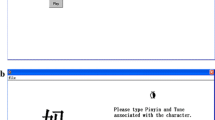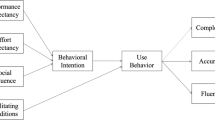Abstract
This study investigated whether orthographic consistency and individual learner differences including working memory (WM), first language (L1) background, and second language (L2) proficiency affect Chinese L2 learners’ literacy acquisition. Seventy American college students in beginning or intermediate Chinese classes participated in a character learning-and-reading experiment, and completed WM tasks and an L2 proficiency test. In the learning phase of the experiment, participants were asked to master 18 unfamiliar Chinese characters of three levels of consistency—consistent, semi-consistent, and inconsistent. Then in the transfer test of the experiment, participants read 60 novel, artificial characters analogous to the learned characters. Significant consistency effects for learning and reading new characters were found, with no effects of WM and L1. In particular, an interaction effect between consistency and L2 proficiency found in the learning phase indicated that participants with higher L2 proficiency learned the fully consistent characters better and faster than those with lower proficiency. These results suggest that L2 proficiency facilitates awareness of consistency, enabling learners to learn novel characters faster and more accurately. The findings of this study are compared with the character acquisition of beginning L1 Chinese readers and with L2 learners’ acquisition of other types of characters.



Similar content being viewed by others
Notes
In this paper, a “second language (L2)” is used as an umbrella term to refer to any language acquired after one’s native language, including both a second language and a foreign language, regardless of the learning context.
In this paper, the pronunciation of a character is in italics with a number indicating the tone.
In this study, learning refers to the learning of new characters in a learning phase, while reading is defined as the transfer from learned knowledge in a transfer test. Latency refers to naming latency, i.e., the time it takes for a participant to pronounce the target character aloud. Details are described in the procedure and materials sections below.
The L1 speakers of Chinese dialects were all Chinese heritage learners who had not received any formal instruction in Mandarin Chinese or Chinese characters before taking Chinese courses at the university.
LME models perform regression analysis on categorical or continuous outcomes, accounting for random subject and item effects in a single analysis (Cunnings, 2012, for a review). Recent studies have concluded that analysis of variance is inappropriate to analyze dichotomous data, such as that seen in our accuracy results (Dixon, 2008; Jaeger, 2008).
References
Akamatsu, N. (2002). A similarity in word-recognition procedures among second language readers with different first language backgrounds. Applied Psycholinguistics, 23, 117–133.
Akamatsu, N. (2003). The effects of first language orthographic features on second language reading in text. Language Learning, 53, 207–231.
Anderson, R. C., Li, W., Ku, Y., Shu, H., & Wu, N. (2003). Use of partial information in learning to read Chinese characters. Journal of Educational Psychology, 95, 52–57.
Atkins, P. W., & Baddeley, A. D. (1998). Working memory and distributed vocabulary learning. Applied Psycholinguistics, 19, 537–552.
Baddeley, A. (2015). Working memory in second language learning. In Z. Wen, M. B. Mota, & A. McNeill (Eds.), Working memory in second language acquisition and processing (pp. 17–28). Bristol: Multilingual Matters.
Chen, X. (2004). Developmental stages in learning to read Chinese characters (Unpublished doctoral dissertation). University of Illinois, Urbana-Champaign.
Chen, X., Shu, H., Wu, N., & Anderson, R. C. (2003). Stages in learning to pronounce Chinese characters. Psychology in the Schools, 40, 115–124.
Comprehensive Chinese Character Dictionary Editorial Board [汉语大字典编辑委员会]. (Ed.). (1993). Comprehensive Chinese character dictionary [汉语大字典: 缩印本] (1st ed.). Chengdu: Sichuan Dictionary Publisher/Hubei Dictionary Publisher.
Conway, A. R. A., Kane, M. J., Bunting, M. F., Hambrick, D. Z., Wilhelm, O., & Engle, R. W. (2005). Working memory span tasks: A methodological review and user’s guide. Psychonomic Bulletin and Review, 12, 769–786.
Cunnings, I. (2012). An overview of mixed-effects statistical models for second language researchers. Second Language Research, 28, 369–382.
Daneman, M., & Carpenter, P. A. (1980). Individual differences in working memory and reading. Journal of Verbal Learning and Verbal Behavior, 19, 450–466.
DeFrancis, J. (1984). The Chinese language: Fact and fantasy. Honolulu: University of Hawaii Press.
Dixon, P. (2008). Models of accuracy in repeated-measures designs. Journal of Memory and Language, 59, 447–456.
Everson, M. E. (1998). Word recognition among learners of Chinese as a foreign language: Investigating the relationship between naming and knowing. Modern Language Journal, 82, 194–204.
Fang, S. P., Horng, R. Y., & Tzeng, O. J. L. (1986). Consistency effect and pseudo-character naming task. In H. S. K. Kao & R. Hoosain (Eds.), Linguistic, psychology and the Chinese language (pp. 11–21). Hong Kong: University of Hong Kong.
Frost, R., Siegelman, N., Narkiss, A., & Afek, L. (2013). What predicts successful literacy acquisition in a second language? Psychological Science, 24, 1243–1252.
Gupta, P. (2003). Examining the relationship between word learning, nonword repetition, immediate serial recall in adults. Quarterly Journal of Experimental Psychology, 56A, 1213–1236.
Hao, M., & Shu, H. [郝美玲, 舒华] (2005). The role of phonetic information in learning new characters for second language learners [声旁语音信息在留学生汉字学习中的作用]. Language Teaching and Linguistic Studies [语言教学与研究], 4, 46–51.
He, Y., Wang, Q., & Anderson, R. C. (2005). Chinese children’s use of subcharacter information about pronunciation. Journal of Educational Psychology, 97, 572–579.
Ho, C. S.-H., & Bryant, P. (1997). Learning to read Chinese beyond the logographic phase. Reading Research Quarterly, 32, 276–289.
Ho, C. S.-H., Wong, W.-L., & Chan, W.-S. (1999). The use of orthographic analogies in learning to read Chinese. Journal of Child Psychology, 40, 393–403.
Jackson, N. E., Everson, M. E., & Ke, C. (2003). Beginning readers’ awareness of the orthographic structure of semantic-phonetic compounds: Lessons from a study of learners of Chinese as a foreign language. In C. McBride-Chang & H. Chen (Eds.), Reading development in Chinese children (pp. 141–153). Westport, CT: Praeger.
Jaeger, T. F. (2008). Categorical data analysis: Away from ANOVAs (transformation or not) and towards logit mixed models. Journal of Memory and Language, 59, 434–446.
Ke, C. (1996). An empirical study on the relationship between Chinese character recognition and production. The Modern Language Journal, 80(3), 340–349.
Kim, S.-A. (2010). Developmental stages in reading Chinese as a second language (Unpublished doctoral dissertation). University of Illinois, Urbana-Champaign.
Kim, S.-A., Christianson, K., & Packard, J. (2015). Working memory in L2 character processing: The case of learning to read Chinese. In Z. Wen, M. B. Mota, & A. McNeill (Eds.), Working memory in second language acquisition and processing (pp. 85–104). Bristol: Multilingual Matters.
Kim, S.-A., & Shin, S.-H. [金善娥、辛承姬] (2015a). Consistency of phonetic families and principles of teaching Chinese as a foreign language [形声字声旁家族的一致性与对外汉语教学]. Chinese Linguistics [汉语学报], 51, 19–30.
Kim, S.-A., & Shin, S.-H. [金善娥、辛承姬] (2015b). Orthographic consistency of educational characters for learners of Chinese as a foreign language [중국어 교육을 위한 신 HSK 한자 일치도 유형분석]. The Journal of Chinese Language and Literature [中國語文學論集], 93, 131–156.
Koda, K. (1999). Development of L2 intraword orthographic sensitivity and decoding skills. The Modern Language Journal, 83, 51–64.
Koda, K. (2005). Insights into second language reading: A cross-linguistic approach. Cambridge: Cambridge University Press.
Koda, K. (2007). Reading and language learning: Crosslinguistic constraints on second language reading development. Language Learning, 57, 1–44.
Koda, K. (2012). How to do research on second language reading. In A. Mackey & S. M. Gass (Eds.), Research methods in second language acquisition: A practical guide. West Sussex: Wiley-Blackwell.
Lin, C.-H., & Collins, P. (2012). The effects of L1 and orthographic regularity and consistency in naming Chinese characters. Reading and Writing, 25, 1747–1767.
Martin, K. I., & Ellis, N. C. (2012). The roles of phonological short-term memory and working memory in L2 grammar and vocabulary learning. Studies in Second Language Acquisition, 34, 379–413.
Matsumoto, K. (2013). Kanji recognition by second language learners: Exploring effects of first language writing systems and second language exposure. Modern Language Journal, 97, 161–177.
McBride-Chang, C. (2004). Children’s literacy development. London: Arnold.
Miyake, A., Friedman, N. P., Rettinger, D. A., Shah, P., & Hegarty, M. (2001). How are visuospatial working memory, executive functioning, and spatial abilities related? A latent-variable analysis. Journal of Experimental Psychology: General, 130, 621–640.
Mori, Y. (1998). Effects of first language and phonological accessibility on kanji recognition. Modern Language Journal, 82, 69–82.
R Development Core Team. (2014). The R project for statistical computing [Statistical analysis software]. Retrieved from http://www.r-project.org.
Seidenberg, M. S. (1985). The time course of phonological code activation in two writing systems. Cognition, 19, 1–30.
Service, E. (1992). Phonology, working memory, and foreign-language learning. The Quarterly Journal of Experimental Psychology, 45, 21–50.
Shah, P., & Miyake, A. (1996). The separability of working memory resources for spatial thinking and language processing: An individual differences approach. Journal of Experimental Psychology: General, 125, 4–27.
Shen, H. H. (2010). Analysis of radical knowledge development among beginning CFL learners. In M. E. Everson & H. H. Shen (Eds.), Research among learners of Chinese as a foreign language (pp. 44–65). Honolulu: National Foreign Language Resource Center.
Shen, H. H., & Ke, C. (2007). Radical awareness and word acquisition among nonnative learners of Chinese. Modern Language Journal, 91(1), 97–111.
Shu, H., Anderson, R. C., & Wu, N. (2000). Phonetic awareness: Knowledge of orthography–phonology relationships in the character acquisition of Chinese children. Journal of Educational Psychology, 92, 56–62.
Shu, H., Chen, X., Anderson, R. C., Wu, N., & Xuan, Y. (2003). Properties of school Chinese: Implications for learning to read. Child Development, 74, 27–47.
Shu, H., Zhou, X., & Wu, N. [舒华, 周晓林, 武宁宁] (2000). Utilizing phonological cues in Chinese characters: A developmental study [儿童汉字读音声旁一致性意识的发展]. Acta Psychologica Sinica [心理学报], 32, 164–169.
Speciale, G., Ellis, N. C., & Bywater, T. (2004). Phonological sequence learning and short-term store capacity determine second language vocabulary acquisition. Applied Psycholinguistics, 25, 293–321.
Tremblay, A., Derwing, B., Libben, G., & Westbury, C. (2011). Processing advantages of lexical bundles: Evidence from self-paced reading and sentence recall tasks. Language Learning, 61(2), 569–613.
Tzeng, O. J. L. (2002). Current issues in learning to read Chinese. In W. Li, J. S. Gaffney, & J. L. Packard (Eds.), Chinese children’s reading acquisition: Theoretical and pedagogical issues (pp. 3–29). Boston: Kluwer.
Wan, Y. [万业馨] (2000). Phonetic radical and teaching Chinese characters for foreign language learners [略论形声字声旁与对外汉字教学]. Chinese Teaching in the World [世界汉语教学], 51, 62–69.
Wang, M., Koda, K., & Perfetti, C. A. (2003a). Alphabetic and nonalphabetic L1 effects in English word identification: A comparison of Korean and Chinese English L2 learners. Cognition, 87(2), 129–149.
Wang, M., Liu, Y., & Perfetti, C. A. (2004). The implicit and explicit learning of orthographic structure and function of a new writing system. Scientific Studies of Reading, 8, 357–379.
Wang, M., Perfetti, C. A., & Liu, Y. (2003b). Alphabetic readers quickly acquire orthographic structure in learning to read Chinese. Scientific Studies of Reading, 7(2), 183–208.
Yin, J. H. [印京华] (2003). The methods of memorizing Chinese characters by American college students. [美国大学生记忆汉字时使用的方法–问卷调查报告]. Journal of the Chinese Language Teachers Association, 38, 69–89.
Zhang, Z.-S. (2009). Myth, reality and character instruction in the 21st Century. Journal of the Chinese Language Teachers Association, 44, 69–89.
Zhang, X. [张熙昌] (2007). On the role of the phonetic elements in the teaching of pictophonetic characters [论形声字声旁在汉字教学中的作用]. Language Teaching and Linguistic Studies [语言教学与研究], 2, 21–28.
Zhou, Y. [周有光] (1978). To what extent are the “phonetics” of present-day Chinese characters still phonetic? [现代汉字声旁的表音功能问题] Studies of the Chinese Language [中国语文], 146, 172–177.
Zhou, Y. [周有光] (1980). Phonetic radical’s pronunciation dictionary [汉字声旁读音便查]. Changchun [長春]: Jilin People’s Publisher [吉林人民出版社].
Acknowledgments
The preparation of the manuscript was supported by research grants from The Hong Kong Polytechnic University to Sun-A Kim (G-YN31) and from Dongguk University in 2015 to Jeong-Ah Shin. The experiment reported here is a portion of the first author’s doctoral dissertation. We thank anonymous reviewers for helpful suggestions and comments on earlier versions of the manuscript.
Author information
Authors and Affiliations
Corresponding author
Appendix
Appendix
Rights and permissions
About this article
Cite this article
Kim, SA., Packard, J., Christianson, K. et al. Orthographic consistency and individual learner differences in second language literacy acquisition. Read Writ 29, 1409–1434 (2016). https://doi.org/10.1007/s11145-016-9643-y
Published:
Issue Date:
DOI: https://doi.org/10.1007/s11145-016-9643-y




